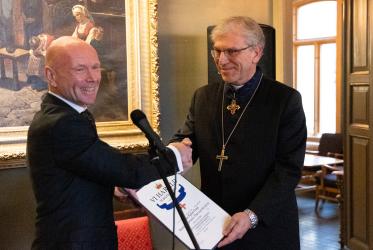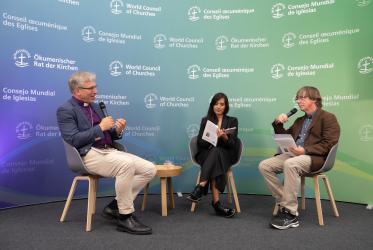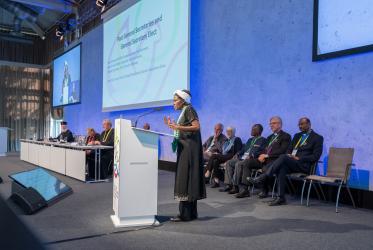Olav Fykse Tveit
Sermon
Knox Church, Christchurch
9 October, 2016
Text: Luke 17:11-19
The pilgrimage of healing, justice and peace
Tena Kotou Katoa.
Dear sisters and brothers in Christ,
The story of how Jesus met with the 10 lepers in the borderland between Samaria and Galilea has a lot to teach us – about many important things. Today I want to share how we can learn from this story a lot about what unity means.
You search for new expressions here in Aotearoa New Zealand of the unity in Jesus Christ. One example is these new forms of common worship among two churches here in this city of Christchurch. The catastrophe of the destructive earthquake made it necessary to find new ways forward, together. You all became homeless as congregations. This common worship is one very visible expression of your pilgrimage together. I am honoured and inspired by the invitation to share the gospel with you here this morning.
As we in the fellowship of the WCC pray and work for our visible unity, we are also called to find new ways forward. We learn from the past, from the strength and the weaknesses of what has been, as we look forward to the only space where we can do something: the future. We only can be the ecumenical movement of today and of tomorrow, not of yesterday. Therefore, we also call our common life and work together in this period a pilgrimage of justice and peace. We are seeking the way forward together, establishing relationships and realities that are named by the values of the kingdom of God, joy, justice, and peace. Today we are reminded that healing is also a dimension of the kingdom of God justice and peace, and that it belongs to our quest for visible unity.
The followers of Jesus Christ are in the gospel of Luke included in the fellowship with him, invited into the circle. At the same time they are challenged to find new ways to express their longing and belonging together, so that the circle can be one of healing, justice and peace, open for others to enter. Jesus himself is going new ways, other ways than expected. The unity of the church is based on the call from and the unity with Jesus Christ. We have met one who has heard our cries, the longing of our heart, and who also challenges us to open the circles we have been invited to. Jesus Christ both includes and challenges – even provokes - at the same time.
This is the case from the first presentation of Jesus of himself, to the last one, in the gospel of Luke. The story of the healing of the lepers must be read in the light of how Jesus presents himself as the one who has come to heal and to proclaim the grace and the liberation of God. This happened as he was reading the words of the book of the prophet (cf. Jes 61/Luke 4) in the synagogue in Capernaum. The servant of God is promoting justice for the oppressed and the healing for the sick and the inclusion of the excluded. Now he is present, here and now. This is challenging, even provoking, implying that something has to be transformed.
This is also the case till the last story about his surprising presence on the way to Emmaus. He again gives a new interpretation of scripture, now in the light of what had happened in Jerusalem, walking and talking with the disappointed and broken disciples on their way to the village of exclusion, to Emmaus. He ended up with them, including them in a meal that transformed into a sign of the kingdom of God. He was thereby challenging them to totally change their minds from sorrow to joy, and to share the new reality, which meant going back to Jerusalem. Their hearts were burning, we are told.
As we are called to be one, we search for new expressions of our unity. We long for what makes our heart burn together. As we follow Jesus Christ, we should not be surprised that we are openly invited and openly challenged by him.
Jesus is meeting the 10 lepers on his way toward Jerusalem through this land “between”, where the tensions are noticeable. The lepers are apparently coming from both the Jewish and the Samaritan communities, from both sides of these borders; one of them (at least) was a Samaritan, we learn at the end.
Already by these remarks we are in the middle of the human drama of division, distance, exclusion, stigmatization, and conflicts, partly based on political, historical realities and traditions, and partly based on religious understanding of who belongs and who does not. Some were excluding the others.
The division between the two groups, the Jews and the Samaritans, was well known and established, an obstacle for the real unity of human beings. They could not touch one another or speak to one another, much less pray together.
There are so many countries where people are divided by their origins, the political and ethnic history have caused the division and distance. You know how you have these realities of a plural background and belonging in your country. Particularly you have dealt with how the indigenous people, the Maori, have had and should have a place here with all their rights, also after the immigration from Europe and other continents. Here in Aoteroa New Zealand you have dealt with it better than many others, as far as I can understand. Still, with many challenges. The identity of each group is still a reason for different treatment, different status and different privileges, and I learn that in practical terms the losers in the race for wealth in the market economy are often those who already had less privileges and who historically had been excluded or losing.
Something made that separation between the two groups less relevant for the 10 as they were living outside. They were all stigmatized, excluded from the communities, due to different types of skin-based diseases; some were contagious, some were not. But they were all classified as lepers, and should, for the sake of the community, be excluded. They lived from the alms given to them by those passing their place. The solidarity of being together in the margins brought them together. Their common cry for mercy, for healing, and through that also their cry for justice and peace with others, united them. They also want to have the same rights and access to the fellowship. To Jesus they cry for more than alms: “Jesus, master, have mercy on us!”
Jesus identified them and their needs as he encountered them. That is the decisive step toward unity with one another as followers of Jesus Christ: that we are seen, given mercy and grace by our Lord and master, Jesus Christ. This qualifies everything in our relationships to one another. We are in those relationships because of his grace, his mercy. In our relationship to Christ we are identified as the beloved, as the included, and therefore, as the united. It is the relationship to Christ that makes us Christians. Jesus spoke to all of them with a message of healing, of hope.
Even more, the healing included restoration of justice, of their dignity and rights, not only as recipients, but as agents of their own lives. They were called to seek a new reality of healing. It was the call to go and be what they were in the eyes and the words of Jesus Christ. Based on that reality they were to be received by those who defined who are included or excluded. They should become human beings who belong to the fellowship of the living, to the unity of the children of God.
Then the miracle happens. Then begins the new reality of unity with Jesus Christ and with all those who are living. The new reality comes when they accept the challenge to go, to go a new way, together.
The risk, the damage of exclusion and stigmatization is clearly demonstrated here. Jesus is not only responding to their cry for attention, but also to their need for coming out of their isolation, out of their deadly exclusion. The work related to HIV and Aids in the WCC has been focused on how to teach the churches to be HIV and AIDS competent. That means to understand how exclusion and stigmatization is a deadly risk, even more of a threat to life for themselves and others.
The place of the marginalized is where Jesus places himself. This did not stop him on his journey, on his pilgrimage towards Jerusalem; it belonged to it. He is not ignoring this reality. He reacts to it with all the proper and adequate words of inclusion and challenge.
The new unity among the stigmatized lepers might have been amazing, maybe even shocking. They all apparently continue to be cured from their disease, but nine of them lost the full healing. Somehow they forgot to participate in the full healing, in the full fellowship that really includes and sends us to our tasks us in the world. They forgot to come and thank and worship the true God.
Unity in the church is based on our call to be one. It is not a theoretical issue, for those who might be interested. The unity in life and of life is coming out of our needs, the needs that can lead us to restoration of our relationship to God through Christ. A human being called into the fellowship with Christ is set free, free to be in relationship to the others, free to belong to the fellowship of the worshipping community. Unity is not for the sake of order in a narrow sense. It is for the sense of life. It is the praise for God’s creation of life.
The one – the “foreigner”, the outsider – became the sign of the real community. Therefore he also became the sign of the community in mission, from the margins and to the margins, from the healed to those who need healing. The transformed disciples are not there for their own sake. The unity among them is not to manifest and protect their comfort zones. It is for them to love the world, sharing the wonderful news that Christ, the healer and the liberator, is here among us, in our church; also in Christchurch.
That is why our fellowship is a community of worship, of thanksgiving. All over the world.
May God bless you, your churches, and the whole Christchurch. Amen.



